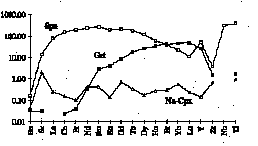
As part of a study to provide information on trace element variations in meta-basaltic assemblages during high-pressure metamorphism and subduction, coesite-bearing eclogites from Dabieshan, central China, are being analysed. Particular attention has focused upon the occurrence of aluminous titanite in these ultra-high pressure eclogites (Carswell et al., in press). The trace element abundances have been obtained using the NERC supported Cameca
ims-4f instrument at Edinburgh University using standard techniques (Harte and Kirkley, in press). Use of the ion microprobe has allowed careful selection of grains for measurement in thin section, and has thus provided a means of determining compositions in primary phases with
no textural evidence of retrogressive alteration. Electron microprobe analyses have been performed adjacent to ion microprobe pits.
Fig. 1 summarises data (chondrite normalised) for a primary mineral assemblage of garnet (Grt), omphacite
(Na-Cpx), aluminous titanite (Spn) and coesite (sample CD28 of Carswell et al., in press). Other samples show similar patterns of relative abundance to CD28, but with some variation in concentration levels; thus garnet has
an overall range for Sm from 1 to 4 x chondrite, whilst aluminous titanite has Sm ranging from 30 to 300 x chondrite. The Cpx/Grt partition coefficients are similar to those of Harte and Kirkley (1994, in press) for appropriate major element composition. The data illustrate the relative enrichment of the aluminous titanite in LILE, LREE, MREE and HFSE with respect to clinopyroxene and garnet. Only the HREE from Er to Lu show greater enrichment in garnet than titanite. For LREE, MREE and Nb trace elements, the enrichment in titanite as against omphacite and garnet is particularly striking, and a very important aspect of the trace element distribution in the rock as a whole.
The data clearly have a bearing on trace element redistribution during high-pressure metamorphism and subduction of basic compositions. The extent to which titanite is involved in any process of fluid or melt mobilization in such rocks, will profoundly affect the trace element abundances of the residual eclogite and the trace element signatures of the fluid or melt passing from the eclogite. The high LILE and REE abundances in titanite, as well as high Nb, mean that it has a different effect to rutile or ilmenite.
Carswell, D.A., Wilson, R.N. & Zhai M., Mineralog. Mag. (in press).
Harte, B. & Kirkley, M.B., Mineralog. Mag. 58A, 388-389 (1994).
Harte, B. & Kirkley, M.B., Chem. Geol. (in press). 
Fig. 1: C1-normalised trace element abundances in titanite, garnet and omphacite from eclogite no. CD28.